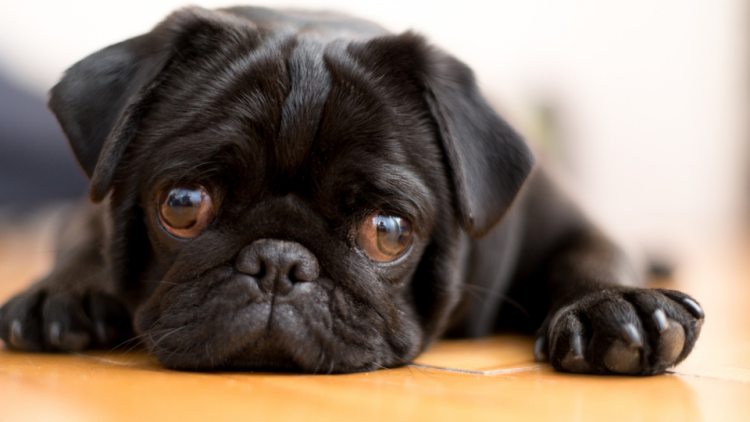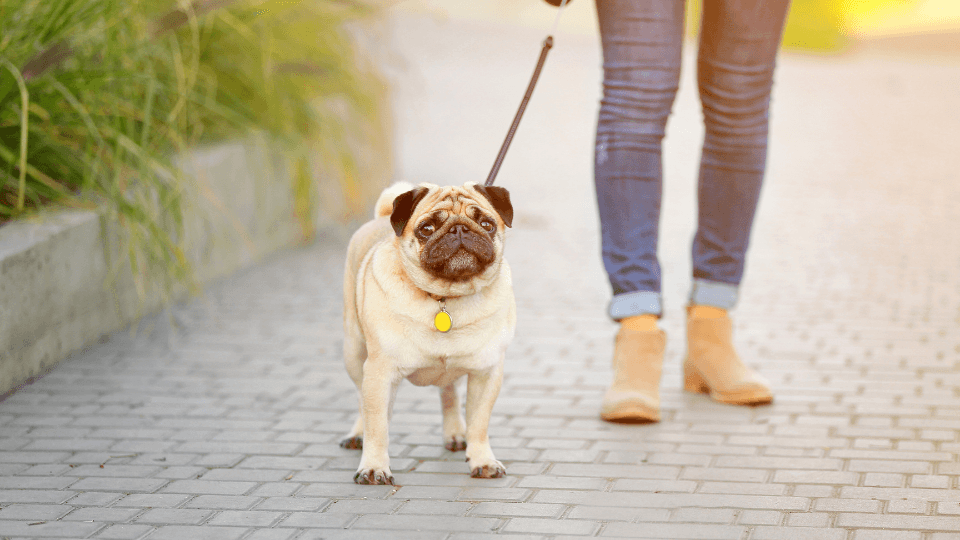Pugs are truly big dogs in small bodies. With their distinctive build, wrinkly forehead, and shiny eyes, these dogs are extremely expressive and capable of displaying a range of emotions. They’re playful, stubborn, and ideal for multi-pet households. However, their cute flattened faces come with some potentially serious health issues.
Wondering if a Pug is the right dog for you? Read on to find out more about this popular breed, including physical traits, personality characteristics, care requirements, history, and more.
Table of Contents:
- Pug Characteristics
- Physical appearance
- Personality and behavior
- Lifespan
- Pug History
- Pug Care
- Training
- Exercise
- Grooming
- Nutrition
- Living with Pugs
- Common Health Issues in Pugs
- Brachycephalic airway syndrome
- Eye problems
- Allergies and skin issues
- Dental issues
- Where to Adopt or Buy a Pug
- Key Takeaways
Pro Tip: Like other breeds, Pugs come with their own set of health issues that could significantly affect your wallet. Compare Pug insurance plans now and make sure your dog gets the best vet care possible if the unexpected happens.
Pug Characteristics
Physical appearance
Despite their stocky build, Pugs are members of the toy breed. They weigh between 14 and 18 pounds and can be 10 - 11 inches tall. Their bodies are square-like, with substantial legs, whereas their heads are big and round, with a short muzzle, and deep forehead wrinkles. Their eyes are dark, shiny, and somewhat protruding, which makes them prone to trauma, and the tail is slightly curled over the hip.
Pugs have a short but dense double coat that comes in different colors: silver, black, fawn, and apricot. All Pugs have a black face mask, except for the black ones.
Personality and behavior
Unlike other toy breeds, Pugs are not very active but they make this up with their big attitude! True to the breed’s motto "multum in parvo," which means a lot in a little, Pugs are big dogs in a small package. Thanks to their distinctive crinkled brow, they’re able to show a range of expressions which makes them very entertaining companions.
Pugs can sometimes be stubborn but typically want to please. Most of them are good with children and generally get along well with other pets. They enjoy company and can be very affectionate, which makes them great companion dogs. Pugs are quite laid-back dogs, not usually prone to excessive barking or destructive chewing as long as they are provided with adequate mental stimulation and physical activity.
Lifespan
The average life expectancy for Pugs is 12-15 years. The average lifespan of male pugs is 12.8 years, whereas female pugs have a slightly longer life expectancy of 13.2 years. The good news is that with good living conditions, your pug can live more than 15 years. For instance, the oldest Pug in America, King Tug the Pug, is 18 years old.

Pug History
The Pug is one of the oldest dog breeds, dating back to about 400 BC. It’s believed that the breed originated in China and descended from the Mastiff or the Bulldog.
During the 1500s and 1600s, Pugs became popular among the nobles and royal families of Europe. William and Mary of Orange brought their Pugs with them when they arrived in England to assume the monarchy and started a real craze for the breed among the British. Queen Victoria Marie Antoinette, and Napoleon's wife, Josephine, as well as many Spanish nobles, all had and loved Pugs.
In 1860 a new wave of Pugs was brought from China to England. These had shorter legs and a slightly different nose, contributing to the Pug appearance we know today.
Pugs were introduced to the US after the Civil War, and the breed was recognized by the AKC in 1885. Today, according to the American Kennel Club, Pugs are ranked 28th on the list of most popular breeds.
Pug Care
Training
Early socialization and puppy classes are recommended. Because these dogs are eager to please they’re generally easy to train. However, their feelings are easily hurt, so harsh training methods should be avoided.
Exercise
As mentioned earlier, Pugs aren’t very active dogs and don’t mind spending much of the day sleeping on the sofa. However, lack of activity combined with the breed’s fondness of food can easily lead to obesity. Pugs are also lively and playful so they enjoy moderate daily exercise such as play sessions in the backyard or walks. It should be noted though, that Pugs aren’t tolerant of hot weather, so they should avoid too much outdoor exertion during hot summer days.
Grooming
Pugs have short, smooth, and glossy coats that require minimal maintenance. However, they do shed so you will need to brush your dog once or twice a week in order to remove the loose hair. Pugs don’t need bathing unless they get particularly dirty or smelly, but their nails should be trimmed on a regular basis. Their facial wrinkles should also be kept clean; a gentle wiping with a wet cloth daily should suffice.
Nutrition
Pugs should be fed up to half a cup of dry dog food twice a day. However, the amount of food will depend on your pup's age, size, and activity level. As mentioned before, Pugs love food and can easily become overweight. For this reason, you should keep an eye on your Pug’s daily calorie intake and avoid feeding too many treats or human food. Talk to your vet for recommendations on how to keep your dog fit and healthy.
Living with Pugs
Pugs want to spend time with their family and don’t like to be left alone for prolonged periods of time. They’re mainly indoor dogs and are good with children and other pets. Due to their short muzzle, they aren’t suited for very warm and tropical climates and should be observed carefully for heatstroke. Pugs tend to snore, also as a result of their short muzzle and constricted airways.

Common Health Issues in Pugs
Brachycephalic airway syndrome
This syndrome is a result of the above-mentioned short, pushed-in muzzle. Like other brachycephalic breeds, Pugs have low tolerance to exercise and are prone to heatstroke, which is why it’s important to avoid physical activity when the weather is very hot or humid. Some dogs do much better with surgery which will widen the nostrils and, as a result, reduce secondary breathing issues as the dog ages.
Eye problems
Pugs are prone to developing dry eye, where the tear glands produce insufficient quantities of the dog's own tears. This means that your dog might need medications for life such as lubricating eye drops and is at risk of suffering from chronic infections and corneal ulcers.
Pugs are also prone to entropion (rolled-in eyelids). Their prominent eyes can get easily injured and must be kept moist.
Allergies and skin issues
Pugs can be prone to skin infections (especially in the skin folds), ear infections, allergies, and anal gland issues. All these can occur simultaneously as a result of atopic dermatitis. In some cases, surgery (facelift) is needed in order to resolve chronic skin infections and/or eye issues.
Dental issues
Small breed dogs often suffer from dental issues, whether due to lack of chewing, poor diet, or predisposing genetic factors. Daily teeth brushing, a diet that involves chewing, and water additives can be helpful. Just like training your pug to sit or stay, training them to tolerate teeth brushing is very manageable and can have large positive impacts on their lifelong oral health.
Pro Tip: Because Pugs can be vulnerable to certain medical conditions, it’s important to insure your pup as soon as possible to make sure any illnesses that develop in later life are covered in your pet insurance plan.
Where to Adopt or Buy a Pug
If you’re looking to buy a Pug, avoid pet stores and try to find a reputable breeder who can provide you with an accurate health history and healthy Pug puppies. If you’re looking to adopt, start by contacting The Pug Dog Club of America or a local pug rescue group.
If you are interested in similar breeds, consider looking into French Bulldogs and Shih Tzus.
You can also look at some Pug breed mixes, such as:
- French Bull Dog + Pug (Frug)
- Beagle+ Pug (Puggle)
- Husky + Pug (Hug)
- Chihuahua + Pug (Chug)
- Dachshund & Pug (Daug)
- Pomeranian & Pug (Pom-A-Pug)
Key Takeaways
- Pugs are stocky and sturdy dogs with an easy-going nature. They’re known to love people, which makes them well-suited to families with children.
- Pugs are easily adaptable to any living condition. With only moderate exercise requirements, Pugs are equally at home in an apartment or a house with a yard as long as regular exercise is provided.
- Due to their short muzzle, Pugs are prone to a number of health issues, so you should be prepared for regular vet visits for preventative care.
